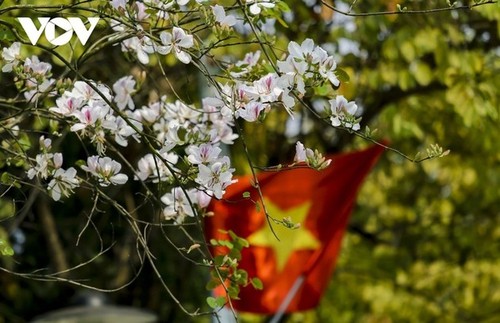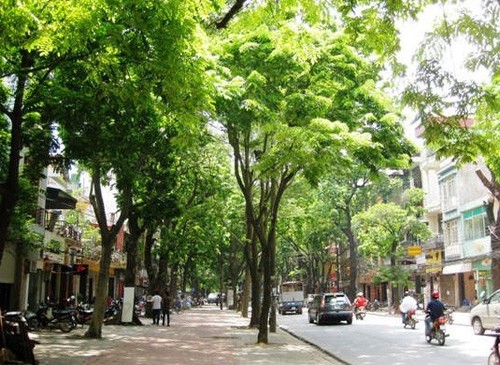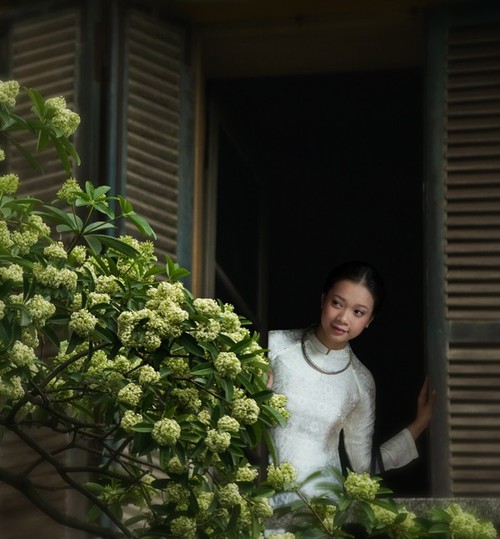 Ban (Bauhinia) flowers are blooming across the streets and forests in Dien Bien province, drawing visitors near and far. Ban (Bauhinia) flowers are blooming across the streets and forests in Dien Bien province, drawing visitors near and far. |
B: In his most recent letter to VOV this week, Jose Luis Blanco Lorenzo of Spain told us that he is an amateur shortwave radio listener. He tuned in to VOV’s English program on February 20 on the frequency of 11885 KHz with SINPO of all 3s.
A: Another shortwave listener, Najimuddin of India wrote: “I wish you a happy World Radio Day 2024. I have been listening to shortwave radio for a long time. I also follow your website and social networks. I’m a fan of VOV because VOV helps me to see and feel Vietnam, its history, art culture, and people. I will visit Vietnam one day. That’s why I’m collecting a lot of information about your country. VOV’s updated and thoroughly analyzed programs help me get a true picture of Vietnam, as well as your perspective about international issues.”
B: In his email to VOV this week, Joandric Ávila Fernández of Costa Rica wrote “Dear friends of the Voice of Vietnam. Best regards to all esteemed colleagues and friends of VOV, I hope you are in good health at the time of reading this letter. I want to highlight my tireless effort to listen to VOV through shortwave, especially its programs in Spanish and English, since I totally enjoy the information from such a great country. On the occasion of all the Vietnamese Lunar New Year celebrations, I have been keeping an eye on your websites which are an excellent source of information about the activities taking place in your country.”
A: Fernández continued “I would just like to tell you that I would like very much for your programs to be expanded so that they can be heard by more listeners here in Latin America.” He also sent us a detailed report for the reception of our program on February 25, from 21:30 to 21:57 UTC on the frequency of 11885 KHz with SINPO from 3 to 5.
B: John Jurasek of the US wrote: “Thank you for maintaining this shortwave radio channel. I’m confident that shortwave radio will reach the people who really need to hear your voices, because it is still very effective in reaching listeners who have no other means of getting update information due to financial circumstances or remote location or as a result of war or disaster”.
A: Ogawa Tatsuya of Japan asked about autumn flowers in Hanoi and would like to know more about the milk flower.
B: Each season in Hanoi has its own floral attraction. But for people living there and those who have visited Hanoi, autumn is considered the best season of the year. Milk flower is praised as one of the symbols of Hanoi’s autumn. When autumn comes, we feel the cool breeze and smell the fragrance of Hoa Sua or Milk Flowers.
 Milk flowers on Phan Dinh Phung street, Hanoi Milk flowers on Phan Dinh Phung street, Hanoi |
A: Not as resplendent as peach blossoms, or flamboyant as chrysanthemums, milk flower has a plain beauty. But its attraction lies in its ardent sweet fragrance. Milk flowers blossom in the late autumn and early winter. The streets, where milk flower abound such as Quang Trung, Nguyen Du, Quan Thanh, Thuy Khue, and Thanh Nien, are carpeted with tiny white flowers. On windless nights, the ardent fragrance makes the autumn atmosphere more romantic and poetic.
B: For Hanoians, milk flowers remind them of cool autumn breezes and pleasant evenings walking around the lake and indulging in their sweet fragrance. For people who are living far away from Hanoi, milk flower perfume will make them reminisce about Hanoi.
 Milk flower tree is as high as the 2-storey building Milk flower tree is as high as the 2-storey building |
A: Milk flower has been an endless inspiration for poets, song writers, and artists to compose evergreen works about Hanoi such as “Remember Hanoi’s Autumn” by Trinh Cong Son and “My Dear Hanoi Streets” by Phu Quang. But the most popular song is probably “Milk Flower” by Hong Dang written in 1978.
B: Each month in Hanoi is a blooming season for one or more specific types of flowers, hence Hanoi is also known as “the city of 12 seasons of flowers”. The unique name comes from the hard work of flower street vendors, who carry the colorful flowers on the back of their bicycles through the streets of Hanoi. Just by the look of the flowers, those who are familiar with the “12 seasons of flowers” in Hanoi can immediately tell which season it is.
A: This week, many listeners expressed their interest in stories about spring festivals and the tradition of going to the pagoda during the early days of the new year to pray for happiness and good luck throughout the whole year. They also asked about the traditions of famous pagodas in Vietnam.
B: Visiting pagodas during the Lunar New Year festivals is not merely an activity associated with Buddhism. It has become an age-old cultural tradition, and an indispensable part of the Vietnamese people’s spiritual life.
A: In the mind of Vietnamese people for generations, Tet not only carries the meaning of saying goodbye to the old and welcoming the new year, but it is also associated with spiritual values and beliefs.
B: After the clock strikes 12 on New Year’s Eve, many people go to nearby pagodas to pray for health and luck for themselves and their loved ones. Many people sincerely believe that all wishes made on New Year’s Eve will come true.
A: Some go to a pagoda not just to pray for good things in the coming year, but also to reflect on what they have done in the past, find peace for their soul and leave all hardship behind.
B: For every Vietnamese, going to a pagoda at the beginning of the year is a traditional custom that has been around for centuries, which contributes to creating a rich national culture.
A: Vietnamese pagodas and temples can be considered time capsules which embrace the long-lasting cultural and historical traits of the different regions of the country. There are numerous pagodas across the country spanning a vast variety of scale.
B: In today’s program, we will check out Quan Su Pagoda, a historical pagoda in Hanoi that dates back to the mid-14th century during the Tran Dynasty. Initially, it served as a reception place for foreign envoys visiting the imperial capital of Thang Long, hence, the name “Quan Su” which means “House of Envoys”.
A: Due to the diversity of envoys from Buddhist countries, a pagoda within the palace complex was essential for their comfort before meeting with the king. Although the palace complex no longer exists, the name “Quan Su” remains to this day.
B: In 1934, the Vietnamese Buddhist Association’s northern branch was established with its headquarters at Quan Su Pagoda. In 1942, the pagoda underwent a major renovation.
A: Quan Su Pagoda worships various Buddhas, Bodhisattvas, and the Zen Master Nguyễn Minh Không, a renowned Zen master active during the Ly Dynasty. Inside the pagoda, you will find a remarkably lifelike wax statue of the late monk Thích Thanh Từ, another of the celebrated Zen masters during the Ly Dynasty, who significantly contributed to the unification of Buddhist sects nationwide.
B: With numerous renovations and constructions over time, Quan Su Pagoda now encompasses various distinctive structures, including a triple-arched gate, a main hall, a library, a guesthouse, monks’ quarters, and lecture halls. The pagoda’s overall architecture amalgamates the essence of prominent northern pagodas.
A: The triple-arched gate is constructed of wooden frames, exuding an ancient charm. Its red-tiled roof presents a distinctive and captivating architectural style. Passing through the gate and a paved courtyard, visitors will arrive at the main hall, a square-shaped space of two stories, surrounded by corridors.
B: The main hall exudes solemnity with its large statues, gold-plated altars, and careful arrangements. The highest altar pays homage to the Three Jewels Buddhas. Following that is the statue of Amitabha Buddha, flanked by Avalokitesvara Bodhisattva and Mahasthamaprapta Bodhisattva. The middle altar pays tribute to Shakyamuni Buddha, and is flanked by Ananda and Mahakasyapa.
A: On the right side of the main hall, there is an altar dedicated to Monk Lý Quốc Sư, also known as Zen Master Nguyễn Minh Không, and two of his disciples. On the left side, there is an altar for Đức Ông, Châu Sương, and Quan Bình. Surrounding the courtyard are the library, reception hall, monks’ quarters, and lecture halls. The rear compound connects to the main hall via a stairwell.
B: This pagoda is a repository of invaluable Buddhist documents and priceless scriptures and remains one of the oldest centers for teaching, research, and the propagation of Buddhism in Vietnam. It stands as a major cultural and religious site among Hanoi’s many attractions, encapsulating the essence of Vietnamese pagodas’ architectural and spiritual beauty.
A: Seeing is believing. We hope to see you soon in Vietnam. That’s all we have for this week’s Letter Box. We’d like to thank all of you for your interest in VOV, for sharing your love for our country, and for sending us your feedback. We hope to see you soon in Vietnam.
A: We welcome your feedback at: English Service, VOVWorld, the Voice of Vietnam, 45 Ba Trieu Street, Hanoi, Vietnam. Or you can email us at: englishsection@vov.vn. You’re also invited to visit us online at vovworld.vn, where you can hear both live and recorded programs.
B: And don’t forget to check out our VOV Media App, available on both the IOS and Android platforms, to hear our broadcasts. We look forward to your feedback on the mobile version of vovworld.vn. Once again, thank you all for listening. Goodbye!